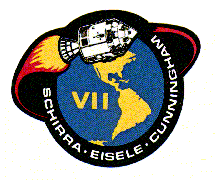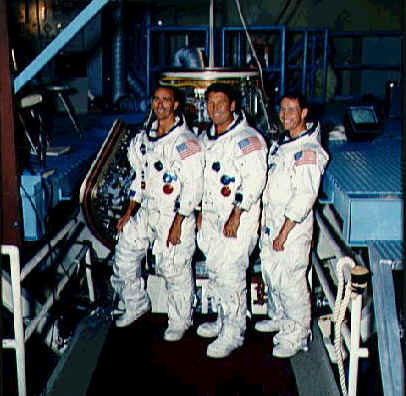
|
||||||||||||
|
|
Apollo 7
Launched 11 October 1968
Donn F. Eisele, CSM Pilot R. Walter Cunningham, Lunar Module Pilot
Apollo 7 was the first crewed flight of the Apollo spacecraft, with astronauts Walter Schirra, Jr, Donn Eisele, and Walter Cunningham on board. The primary objectives of the Earth orbiting mission were to demonstrate Command and Service Module (CSM), crew, launch vehicle, and mission support facilities performance and to demonstrate CSM rendezvous capability. Two photographic experiments and three medical experiments were planned. The command module (CM), a cone-shaped craft about 390 cm in diameter at the large end, served as a command, control, and communications center. Supplemented by the service module (SM), it provided all life support elements for the crew. The CM was capable of attitude control about three axes and some lateral lift translation. It also served as a buoyant vessel at sea. The SM provided the main propulsion and maneuvering capability. It was jettisoned just before CM reentry. The SM was a cylinder 390 cm in diameter and 670 cm long. The spacecraft mass of 14,781 kg is the mass of the CSM including propellants and expendables. There was no lunar module or boilerplate unit on this flight. After launch at 15:02:45 UT on 11 October 1968, The S-IVB/CSM was put into a 228 x 282 km Earth orbit. Venting of S-IVB propellants raised the orbit to 232 x 309 km over the next three hours, at which time the S-IVB stage was separated from the CSM. The S-IVB stage was then used for rendezvous maneuvers over the next two days. Shortly after liftoff the commander, Schirra, reported he was developing a bad head cold. The next day the other two crew members also reported symptoms. The zero-gravity environment exacerbated the cold conditions because normal drainage of fluids from the head did not occur. Medication was taken, but the colds caused extreme discomfort to the crew throughout the mission. This hampered performance of some of the scheduled duties. During re-entry the astronauts did not wear their helmets to make it possible to properly clear their throats and ears. Many tests were performed over the 11 day mission, including tests of sextant calibration, attitude control, evaporator, navigation, rendezvous radar, thermal control system, and service module propulsion systems. Seven television transmissions were made from Apollo 7, the first live TV transmissions from a piloted U.S. spacecraft. The S-IVB orbit decayed on 18 October and it impacted in the Indian Ocean at 9:30 UT. On 22 October at 10:46 UT the SM was jettisoned and re-entry of the CM and crew started 10 minutes later. Apollo 7 splashed down in the Atlantic Ocean on 22 October 1968 at 11:11:48 UT (7:11:48 a.m. EDT) after a mission elapsed time of 260 hrs, 9 mins, 3 secs. The splashdown point was 27 deg 32 min N, 64 deg 04 min W, 200 nautical miles SSW of Bermuda and 13 km (8 mi) north of the recovery ship USS Essex. The Apollo 7 Command Module is on display at the Canada Science and Technology Museum, Ottawa, Canada. Credit NASA |



